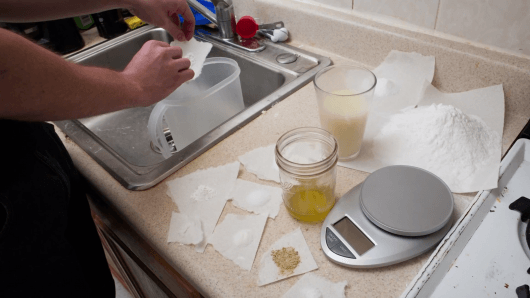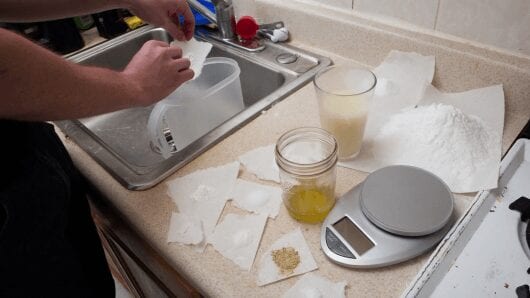
It lasts for years without refrigeration, preparing it is as easy as measuring out your daily dose and mixing it with water
There’s a romance to food. It’s one of life’s great sensory and social pleasures. But a lot of us don’t eat healthily, and a lot of us don’t enjoy the process of preparing food, especially when we’re eating alone. Furthermore, the way we eat today is incredibly wasteful throughout the entire production and consumption process, to the point where it actively damages our bodies and our planet. Enter Soylent: a food engineered to efficiently deliver 100 percent of the healthy body’s needs with minimal waste, junk food-beating convenience and a very low cost, or, as the inventors put it, “creating an efficient form of fuel for humanity for the first time in history.” Food has always been sexy, and this sounds about as exciting as artificial insemination. But when you check out the details, this ambitious plan actually makes a lot of sense.
This is a tough project to look at objectively, because food ranks alongside sex and sleep as one of the great pleasures of life. The subtle dance of flavor and texture, the mystery of the exotic, the social ritual of the shared meal that has glued families, tribes, friends and clans together for hundreds of thousands of years.
But if you can look past the romance and think about food rationally, there are some pretty significant problems with the way we eat in the developed world. For starters, it’s wasteful. If two things cost the same and one is bigger, we’ll go for the bigger one, all else being equal. American restaurant serving sizes have taken this to its logical conclusion. The result is either overeating or perfectly good food going in the bin, not to mention the packaging waste of all that extra food.
Secondly, a lot of us aren’t very good at it. I’d be fascinated to know what percentage of the population genuinely eats well, according to what the body needs, as opposed to overdoing it on the sugars, or salts, or carbs, or fats, or simply leaving out important nutrients because we felt like eating something else that day.
Thirdly, and more broadly speaking, there are supply chain issues. Steak, many people agree, is very tasty. But the land, water, feed and emissions cost of producing it is massive. As we have noted before, the calorie yield of a piece of meat is typically around one fifth of the calorie yield of the grain you’ve fed to raise that cow. Every time I eat a steak, I’m effectively throwing away four times that amount of calories. So I’m prepared to go along with Rob Rhinehart when he says there’s got to be a better way.
The Latest Bing News on:
Replacing food
- Replacement Straw Compatible with Stanley 40 oz 30 oz Cup Tumbler, Now 57% Offon April 27, 2024 at 8:07 am
If you purchase the Replacement Straw Compatible with Stanley Cup Tumbler off Amazon, they also offer a full refund or an exchange if you're not satisfied with the product for any reason. This ...
- Would someone to come to my home to replace a broken alternator? | Car Doctoron April 26, 2024 at 2:07 am
Depending on the vehicle, an alternator could be easy to replace or take several hours, depending on its location. As an example, a 10-year-old Honda Accord may take 30 minutes to replace the ...
- Is Natural Hormone Replacement Therapy Better?on April 25, 2024 at 2:11 pm
Natural hormone replacement therapy (NHRT) is considered an alternative approach to conventional hormone replacement therapy (HRT). It may use natural or " bioidentical " treatments to restore ...
- Scientists replace fishmeal in aquaculture with microbial protein derived from soybean processing wastewateron April 25, 2024 at 9:16 am
Scientists from Nanyang Technological University, Singapore (NTU Singapore) and Temasek Polytechnic have successfully replaced half of the fishmeal protein in the diets of farmed Asian seabass with a ...
- Aldi Clarifies Whether It Is Replacing Cashiers with AI Technologyon April 22, 2024 at 5:03 pm
Aldi tells PEOPLE that customers will still have the option to shop at its grocery stores with a " traditional cashier.” ...
- Public health efforts urged to reduce sodium in packaged foodson April 22, 2024 at 7:13 am
The dual role of sodium in water balance regulation and food formulation, noting its significant association with mortality due to excessive intake.
- CCHD releases food inspectionson April 18, 2024 at 5:38 pm
The following information is obtained from the Clinton County Health District and is compiled from inspection reports. Violations are either critical or non-critical. Critical violations are more ...
- Nassau Community College's food options shut down as vendor looks to renegotiate contracton April 18, 2024 at 3:29 pm
NCC officials said that they are “actively exploring several options for temporary food services” for the remainder of the semester.
- Meal Replacement Bars Market to Witness Steady Growth with a CAGR of 8.05% from 2022 to 2032on April 18, 2024 at 12:38 am
The meal replacement bars market is expected to witness growth at a CAGR of 8.05% and reach a valuation of US$ 25.6 Bn by 2032, as per Future Market Insights (FMI). Preference for low-fat, low-calorie ...
- Feeling rushed at the food ordering kiosk? You're not aloneon April 16, 2024 at 10:45 am
If you've been to a fast-food restaurant recently, you've probably noticed that self-service kiosks are beginning to replace human workers. But as you go to place your order and the lunch-rush crowd ...
The Latest Google Headlines on:
Replacing food
[google_news title=”” keyword=”Replacing food” num_posts=”10″ blurb_length=”0″ show_thumb=”left”]
The Latest Bing News on:
Meal replacement products
- The best meal kits for weight loss and fitness-friendly eatingon April 24, 2024 at 1:13 pm
The best meal kits can also help you avoid pitfalls like excessive added sugars or high-sodium intake, two big drivers of unhealthy diets in recent years. "Meal kits provide fresh ingredients that are ...
- Top 8 Best Tasting Meal Replacement Shakes in 2024on April 23, 2024 at 11:05 am
Look for brands that have a good reputation for producing high-quality meal replacement shakes. You can read reviews online to get an idea of what other people think of the brand and its products.
- Healthy living made easy with Protein Works’ wide range of protein shakes, nutritional supplements and meal replacementson April 18, 2024 at 7:00 am
Making smart decisions around your health and nutrition should be a welcoming experience that rewards enthusiasm and participation regardless of where you are on your wellness journey. That’s why ...
- Best meal delivery services: The top tastes out there nowon April 18, 2024 at 1:50 am
Anyone who wants to eat well, mix up the menu, or simply skip grocery shopping owes it to themselves to check out this list of the best meal delivery services.
- Meal Replacement Bars Market to Witness Steady Growth with a CAGR of 8.05% from 2022 to 2032on April 18, 2024 at 12:38 am
The meal replacement bars market is expected to witness growth at a CAGR of 8.05% and reach a valuation of US$ 25.6 Bn by 2032, as per Future Market Insights (FMI). Preference for low-fat, low-calorie ...
- Top 8 Best Meal Replacement Supplements in 2024on April 15, 2024 at 5:00 pm
Meal replacement products are becoming increasingly popular because they offer a fast and easy solution for individuals to receive the nutrients they require. These supplements are crafted to ...
- Meal Replacement Market To Reach USD 21.3 Billion By 2032 | DataHorizzon Researchon April 15, 2024 at 5:00 am
The meal replacement market size was valued at USD 12.8 Billion in 2023 and is expected to reach a market size of USD 21.3 Billion by 2032 at a CAGR of 5.8%.Fort Collins, Colorado, April 15, 2024 ...
- Best meal replacement shakes: Great tasting diet drinks to help with weight losson April 2, 2024 at 4:59 pm
While the Special K Challenge was designed as a short-term solution, “MRP (Meal Replacement Products) can be used indefinitely to replace a meal or two per day, provided the dieter is still ...
- Optavia Diet Review: Does This Program Really Work for Weight Loss?on April 2, 2024 at 10:24 am
The diet company relies on meal replacements called "fuelings," which are branded products designed to keep you full until your next fueling. No matter which meal plan you choose, you'll be eating ...
- Dietitian Guidance Pivotal in Teen Weight Managementon March 28, 2024 at 3:03 pm
The restrictive nature (45% of participants) and taste of meal replacement products (20% of participants) were liked least. The researchers conclude that a health professional-monitored VLED can ...
The Latest Google Headlines on:
Meal replacement products
[google_news title=”” keyword=”meal replacement products” num_posts=”10″ blurb_length=”0″ show_thumb=”left”]










